Deutsche Demokratische Republik (DDR) 1949-1990
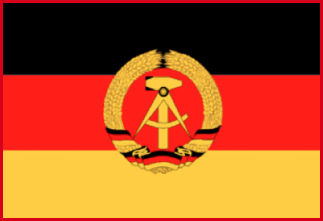 The Soviet Premier Nikita Khrushchev called Berlin 'that espionage swamp'. He was correct though his remarks would have applied (at least) equally well to East Berlin as to West.
The Soviet Premier Nikita Khrushchev called Berlin 'that espionage swamp'. He was correct though his remarks would have applied (at least) equally well to East Berlin as to West.
Berlin was an enclave 150 miles inside what was East Germany (officially the Deutsche Demokratische Republik - DDR). The city was administered by the four victorious World War 2 powers; the Soviet Union (Russia), the US, Britain and France. In effect this meant that the city was divided into two zones, the eastern, under Russian control and the western under the control of the other three.
The Soviets detested the presence of the western powers in the city and considered it a 'carbuncle on the hide of Socialism'. As a consequence the East Germans/Soviets were unsparing in their efforts to make life in it as uncomfortable as possible for its 2.5 million inhabitants. But for the West German government (and the three western powers) it was the experiment that just had to work. So West Berliners were free from the universal military draft, had subsidised housing and other lifestyle incentives not available to the ordinary citizens of the Federal Republic (FRG). They needed them. For the twenty years of the 'high Cold War' (1950-1970) Berlin was the flashpoint, the risk of invasion very real, the sense of claustrophobia all-pervasive.
But for West Germany and their American, French and British allies it wasn't so much about making West Berlin work as about having a listening post deep in the communist heartlands, a spying opportunity like no other.
In furtherance of this the Americans built a giant electronic eavesdropping post in Teufelsberg, (Devils Mountain), so-called because it was built from the rubble of the bombed out city. Its powerful receivers could listen in radio chatter between Soviet tank crews as far away as the Ukraine.
And they established major HUMINT espionage bases, the British in the London Block, the site of the former Olympic Stadium. The Americans in Clay Barracks and Berlin-Dahlem, home of the BOB, Berlin Operations Base, nerve centre for their anti-Soviet ops.
And since the East and West German regimes detested one another as only 'family members' can they spied even more. The East German HVA (acting as Soviet surrogates) penetrated West German political, intelligence and military establishments almost at will. For its part the West German's BND also penetrated the East German regime, if not at will then nearly so, for the DDR may have inspired fear in its population but rarely loyalty. And while the West Germans passed over virtually all of the intelligence they gleaned to the Americans and British, their newfound friends were more prudent about what they shared with their former enemy, seeing it akin to handing it back to the other side. Not for nothing was Cold War espionage christened the 'wilderness of mirrors'.
Both the CIA and SIS were represented in Berlin. Initially their presence was restricted to the west of the city but following the formal recognition of the DDR in the mid-seventies both services established stations in their newly opened East Berlin diplomatic missions. But so intensive was the surveillance that the stations were rendered almost inoperable. The CIA referred to its as the 'Brandenburg Training School' because the Agency considered it to be good only for initiating graduates from 'The Farm' (their spy school in Camp Peary) into the realities of operational life in totalitarian regimes.
The DDR was a state with a level of surveillance unmatched in history. At the time of the 'Wende' in November 1989, which signalled the end of the regime, the East German security apparatus had 102,000 fulltime employees. On top of that there were an estimated 173,000 collaborators (iM's for inoffizieller Mitarbeiters), plus the VoPo's of the Deutsche Volkspolizie (a barracked police service) and assorted specialist policing and border control units.
Some of the collaborators were paid while others were press-ganged. Very few citizens had the courage to stand against the pressure to co-operate. It was a case of 'to survive one had to get along' and if that meant parents spying on their children, spouses on one another then so be it.
The socialist party and its organs were all-encompassing, all pervasive. For example throughout the entire school system (by 1989) there was only one school principal who was not a Party member. That practice applied in virtually all forms of life, the Party ruled and looked as if it was going to continue that way for the foreseeable future.
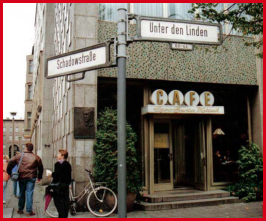 Egon Kisch Café-Unter den Linden, East Berlin. Photo © Paddy Hayes.
Egon Kisch Café-Unter den Linden, East Berlin. Photo © Paddy Hayes.
Egon Kisch was a noted Soviet sympathiser and communist journalist/agitator. He was born (and is buried) in what was Czechoslovakia. He is now best remembered for an extraordinary attempt to visit Australia in 1934. A noted linguist, fluent in 7 languages, he was ultimately refused permission to stay for failing to pass a proficiency test in Scotch Gaelic. Go figure.
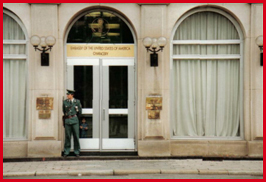 A VoPo guards the chancery of the US Embassy.
Photo © Paddy Hayes.
A VoPo guards the chancery of the US Embassy.
Photo © Paddy Hayes.
Western diplomatic legations were subject to both covert and overt surveillance by the East German authorities. Most had guards stationed at their entrances, ostensibly for 'security' purposes. Observation posts were also situated in close proximity to the more significant ones, (see next photo). In addition all public telephones within a given radius were monitored on a twenty-four hour basis. More than one attempted escapee was apprehended after telephoning their intentions to the embassy from a nearby phone. VoPo's were typically armed with holstered machine pistols, as is this one. Its weight can be seen tugging at his belt. Behind the VoPo (and inside the chancery) can be seen a belligerent looking model soldier.
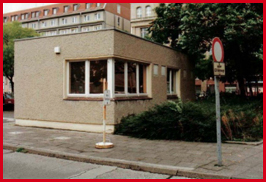 Static Observation Post facing US Chancery in East Berlin.
Photo © Paddy Hayes.
Static Observation Post facing US Chancery in East Berlin.
Photo © Paddy Hayes.
Observation posts such as this were typical of the type used to monitor Western outposts. The windows were coated in a reflective bronze coloured material hiding those inside (and their equipment) from view.
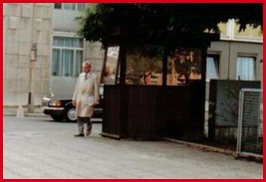 Static Observation Post- general street version.
Photo © Paddy Hayes.
Static Observation Post- general street version.
Photo © Paddy Hayes.
Observation posts such as the one above were to be seen dotted around the more important (or sensitive) streets in East German cities. The bronze coloured material on the windows was seen on many government building in the DDR.
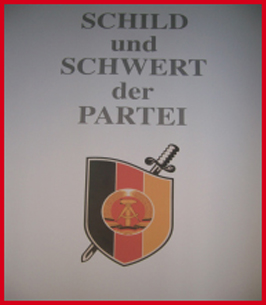 Emblem of the East German Stasi (Ministry for State Security).
Emblem of the East German Stasi (Ministry for State Security).
The motto of the Stasi "The Sword & Shield of the Party" was identical to that of their Soviet masters in the KGB (see image below). Notwithstanding that there was precious little real trust evidenced by the Soviets towards their East German fraternal "allies", for example the locations of Soviet nuclear weapon stockpiles in East Germany was kept secret from the East German authorities.
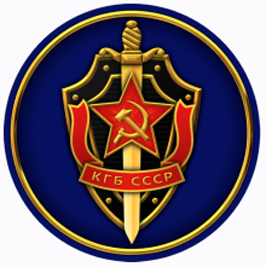 Emblem of the Soviet Union's KGB (Committee for State Security).
Emblem of the Soviet Union's KGB (Committee for State Security).
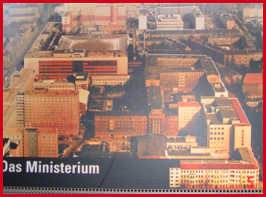 The vast headquarters of the Ministry for State Security (Ministerium für Staatssicherheit) in East Berlin. Officially abbreviated to MfS but more usually referred to as the Stasi.
(Photo; From BStU museum)
The vast headquarters of the Ministry for State Security (Ministerium für Staatssicherheit) in East Berlin. Officially abbreviated to MfS but more usually referred to as the Stasi.
(Photo; From BStU museum)
Tens of thousands laboured here (and in hundreds of other offices) chronicling the lives of the citizens of the DDR in extraordinary detail. There were 49 buildings in total occupying an area the size of Whitehall in London. Building Number 1 was where the minister, Edwin Mielke, had his office. His complement of 102,000 direct employees (for a population of 17 million) compares with about 40,000 in the Gestapo for the entire 3rd Reich of 80 million. The Soviet KGB (no slouch when it came to these matters) employed an estimated 480,000-fulltime personnel for its 280 million population though that number included regiments of uniformed troops such as Border Guards. A more telling comparison would be with the number employed in the UK's internal & external security/intelligence services, MI5 and SIS (SIS). Over the Cold War between them the agencies employed an average of about 4,000 for Britain's 57 million people (up to over 6,000 now though to counter the threat from Islamic terrorism).
The spy to population ratio is interesting.
UK - One member of MI5/SIS for every 14,250 citizens
Soviet Union - One member of the KGB for every 583 citizens
Nazi Germany - One member of the Gestapo for every 2,000 citizens
East Germany - One member of the Stasi for every 166 citizens
If the number of iM's (collaborators) were to be factored in, the ratio in East Germany would be one secret policeman/collaborator for every 66 citizens. To achieve that ratio in the UK, MI5/SIS between them would have to employ almost ONE MILLION officers/agents – (collectively they currently employ about 6,000). And while the comparisons may not be exact they are exact enough. The following illustration, which shows the location of the Stasi regional and district office throughout East Germany, illustrates the point.
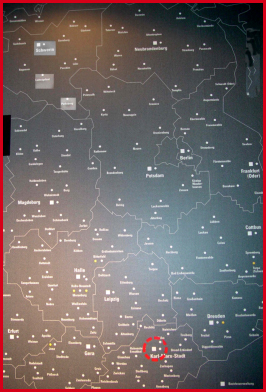 Stasi Regional and District offices in the DDR.
(Photo from BStU museum)
Stasi Regional and District offices in the DDR.
(Photo from BStU museum)
There were 15 Regional Administration centres, 209 District Service Units and 7 Target Service Units (units based in politically or militarily sensitive facilities such as the Griefswald/Lubmin Atomic Power Station) in the Stasi. One man, Edwin Mielke, controlled the organisation for virtually all of its life and his. For example every officer in command of all 15 Regional Offices, 209 District Offices and the 7 Target Service Units had orders to report any 'unusual happenings' in their patch at once direct to the Minister's office. There was nothing he did not want to know.
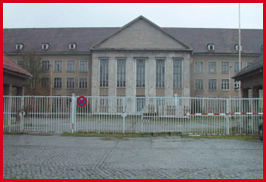 (Former) KGB Berlin Headquarters, located in what had previously been the Sankt Antonius Hospital in Karlshorst in the eastern part of East Berlin.
Photo © Paddy Hayes.
(Former) KGB Berlin Headquarters, located in what had previously been the Sankt Antonius Hospital in Karlshorst in the eastern part of East Berlin.
Photo © Paddy Hayes.
Up to 2,000 KGB officers were stationed in Karlshorst, on the eastern outskirts of East Berlin. The district was an intelligence treasure trove; home to the Berlin Border Command Centre of the National Volksarmee; home to the KGB Intelligence Residency for East Germany (above), home to the Soviet Military Administration HQ and more besides. In an area about one mile square, lived and worked the cream of the Soviet occupation forces. With the possible exception of the GSFG (Group of Soviet Forces Germany) HQ in Zossen-Wunsdorf the intelligence residency was the prime CIA and SIS intelligence target.
The Soviet obsession with bureaucracy helped in their task. KGB officers checking into the KGB guesthouses were obliged to register in their real names for accounting purposes. This gave low-level agents such as cleaning staff the opportunity to detect their real identities. This was of particular interest to the West, not just because knowing who is in town can be a pointer to current and future activity but it also helped build up the 'true-name' biographies of key KGB officers and thus the order-of-battle of the organisation.
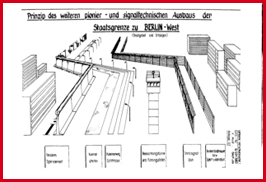 Die Mouer- The Wall. An East German Border Troops illustration of the fortifications marked 'Geheime' (secret). The West is to the left of the picture, the East to the right. On its eastern side are arrayed mine fields, trip wires setting off automatic machine guns, arc lights, watch towers, a second fence and a 'back-up' or hinterland wall.
Die Mouer- The Wall. An East German Border Troops illustration of the fortifications marked 'Geheime' (secret). The West is to the left of the picture, the East to the right. On its eastern side are arrayed mine fields, trip wires setting off automatic machine guns, arc lights, watch towers, a second fence and a 'back-up' or hinterland wall.
Agent handling for Western intelligence services posed major problems. Prior to the erection of the Berlin Wall in 1961 agents slipped across the open border to hand over information, be briefed and rewarded. When the Wall was built that route was closed other means had to be found. Crossing the Wall clandestinely was too dangerous and was not attempted. Agents tended to be recruited as the opportunity presented itself, for example while on approved visits to the West to see family or as part of official delegations or sponsored trips. Others who volunteered their services found their own means to make clandestine approaches. Communication from West to East was often by OWVL (one way voice link) whereby agents listened in to coded broadcasts on their household radio receivers (pace World War II). Specialist radio operators communicated the intelligence back to the West. They were a scarce resource (radio direction finding by Stasi counterintelligence was very intensive) so they were protected as best possible. The intelligence was delivered to them via dead drop by other specialist 'courier agents' (usually car owners) who collected it from the originators (usually also via dead drops or other cut outs). Transmission of original documents was even more difficult. East German citizens who had permission to cross the border on a regular basis (grenzgangers) were recruited for that task. They were often paid for their work.
Double and treble crossing was rife. An agent's shelf life tended to be short and the penalties long. Death or a lengthy term of imprisonment in Bautzen Prison was the norm. It is estimated that over the lifetime of the Regime the authorities imprisoned approximately 250,000 of their own citizens for offences against the State. These would have varied from the serious (like espionage or attempting to leave the territory without permission) to more 'minor offences' such as telling an anti-Party joke.
Agents need to be serviced and this means face-to-face meetings at least once a year. The general rule obtaining in SIS at the time was that visits to the East were prohibited without the specific authorisation of the Foreign Secretary.
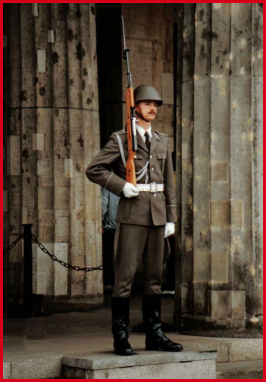 Stasi honour guard at the Neuwe Wache Memorial.
Photo © Paddy Hayes.
Stasi honour guard at the Neuwe Wache Memorial.
Photo © Paddy Hayes.
The Stasi had its own elite uniformed guard force numbering about 11,000, the 'Feliks Dzerzhinsky Wache Regiment'. As with virtually every aspect of the organisation it was modelled on its KGB Soviet Chekist counterpart. Its duties were both ceremonial (it took pride of place in march-pasts at State parades) and practical (being responsible for the physical security of key Stasi installations). Even though they were an elite their working conditions were far from, for example they had the use of hot water only once a week for showering. The Neuwe Wache memorial (pictured) has in turn been a memorial to the war dead of World War I, Hitler's fascists, Communists.
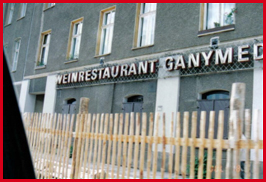 The Weinrestaurant Ganymed.
The Weinrestaurant Ganymed.
Photo © Paddy Hayes.
Before die Wende this establishment was in the ownership of the DDR government. It was the finest restaurant in East Berlin. The haunt of the players of the Berlin Ensemble who still ply their trade just two doors away and who still eat and drink there. Bertold Brecht founded the Ensemble in 1949, 'the people had bread and it was thought necessary to provide a circus'. But this restaurant was also the haunt of players of a certain other kind being a virtual branch office of the HVA (the Stasi's foreign intelligence gathering department). Today the restaurant is in private ownership, the letters 'wein' have been dropped and the dining room has been extended. The original room is still in existence. It is a good (though quite expensive) place to dine in mitte Berlin.
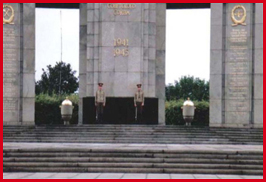 The Soviet War Memorial in Berlin.
The Soviet War Memorial in Berlin.
Photo © Paddy Hayes.
The 2,200 Red Army soldiers who died storming the Reichstag are buried here. The memorial was completed within months of the war's end and was sited in the West of the city in the Tiergarten. 350,000 Soviet soldiers lost their lives in the Battle for Berlin. That price in blood was never far from Soviet minds.
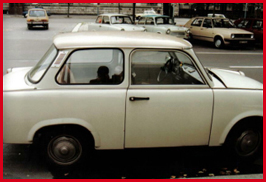 The famous Trabant or 'Trabi'.
The famous Trabant or 'Trabi'.
Photo © Paddy Hayes.
The 'Trabi' was the car of choice (they had no other choice) for the East German population, when they could get one. A polluters dream its emission levels would earn a prison sentence in most countries today.
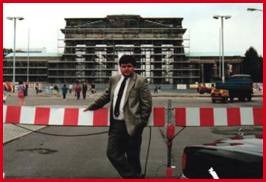 Paddy Hayes on a visit to both East Berlin shortly after the Wall was breached.
Paddy Hayes on a visit to both East Berlin shortly after the Wall was breached.
Photo taken on the Western side © Paddy Hayes
One of the earliest acts of the West German authorities was to commence work on restoring the city's great symbol the 'Brandenburger Tor' and in particular the Quadriga and Goddess of Victory which sit on top. The 'new' Tor was unveiled in October 1990 when the two Germany's were reunited. The restored goddess with her original Iron Cross and Eagle back in place was completed in July of the following year.










